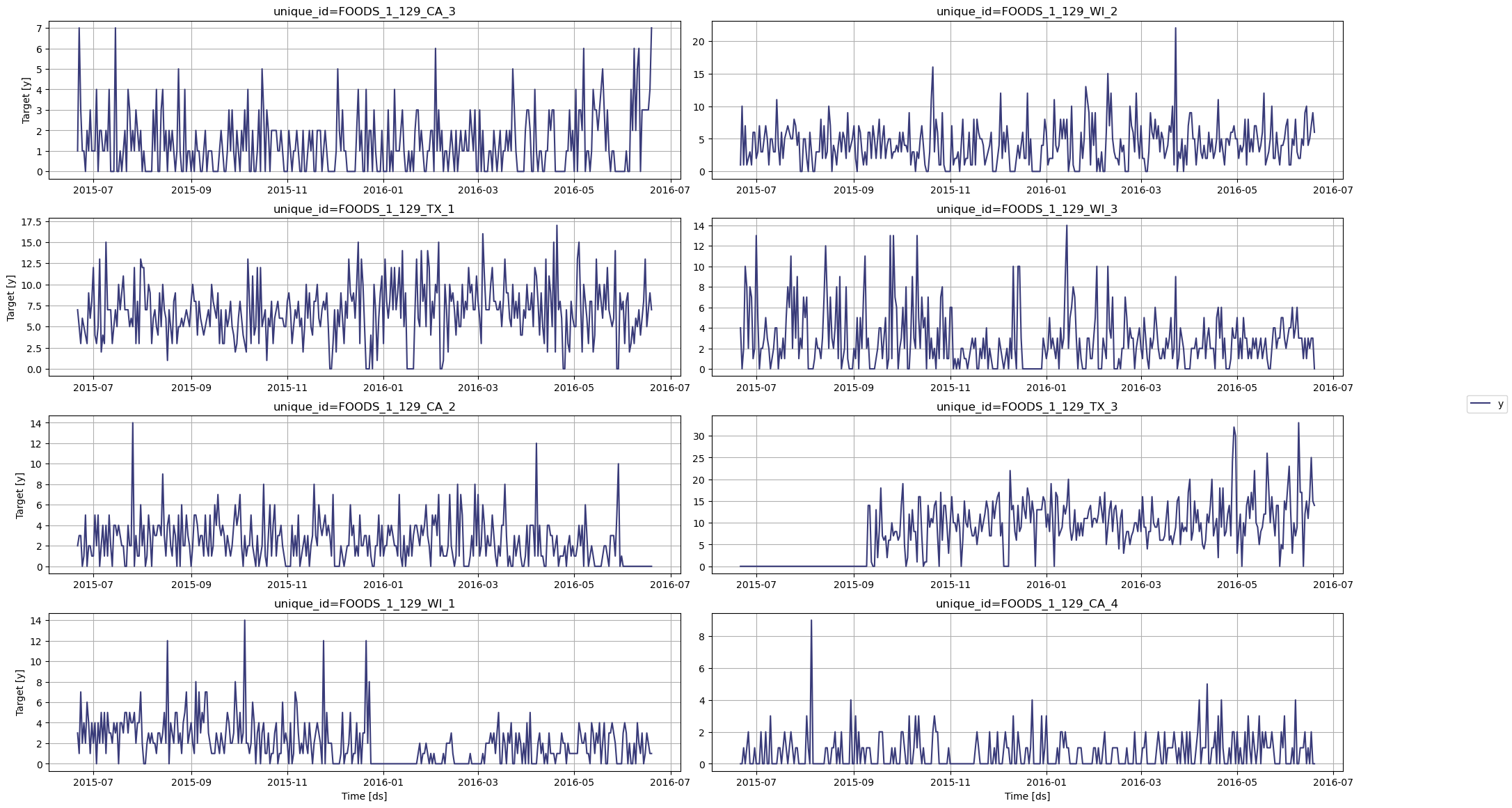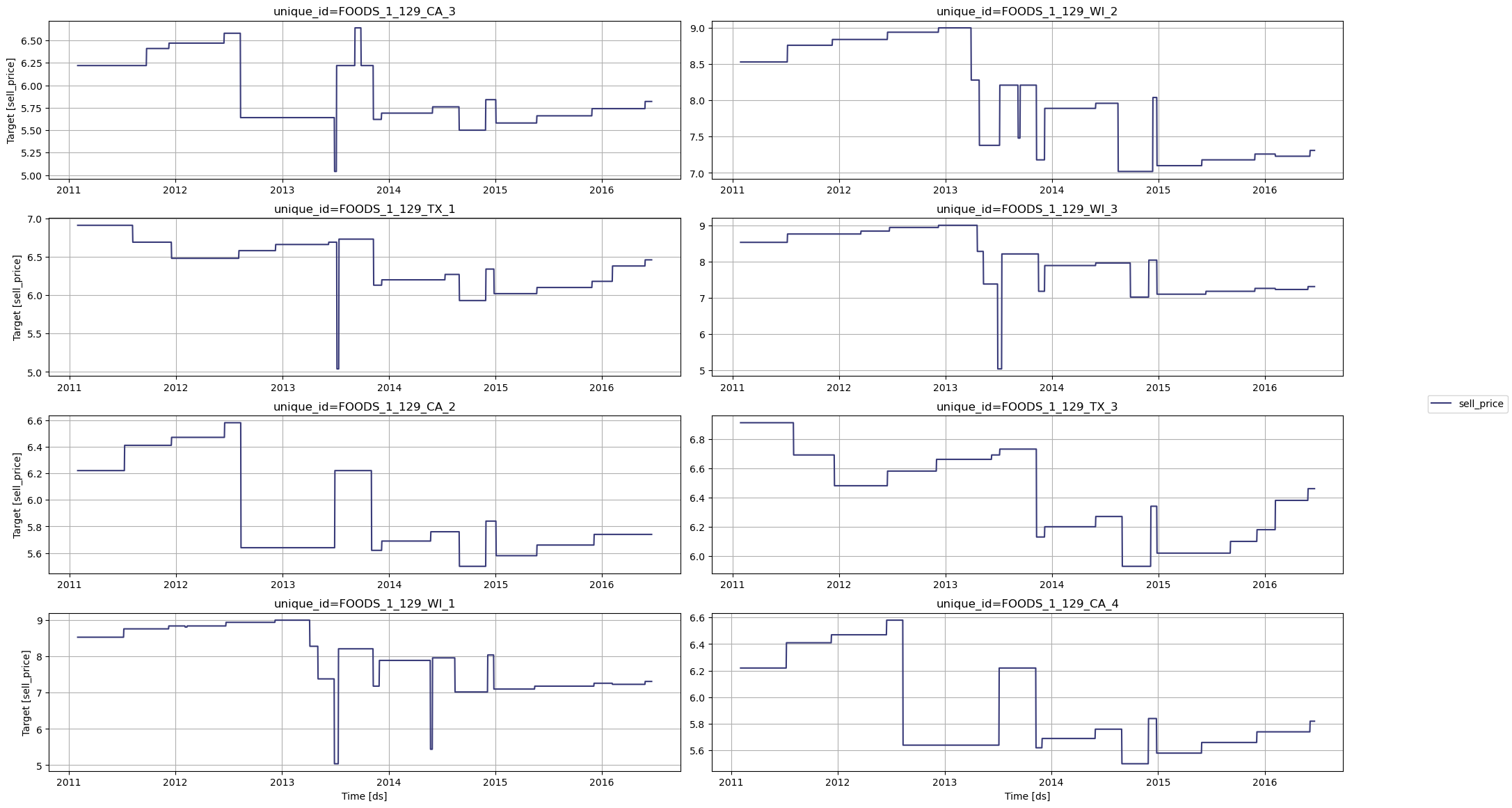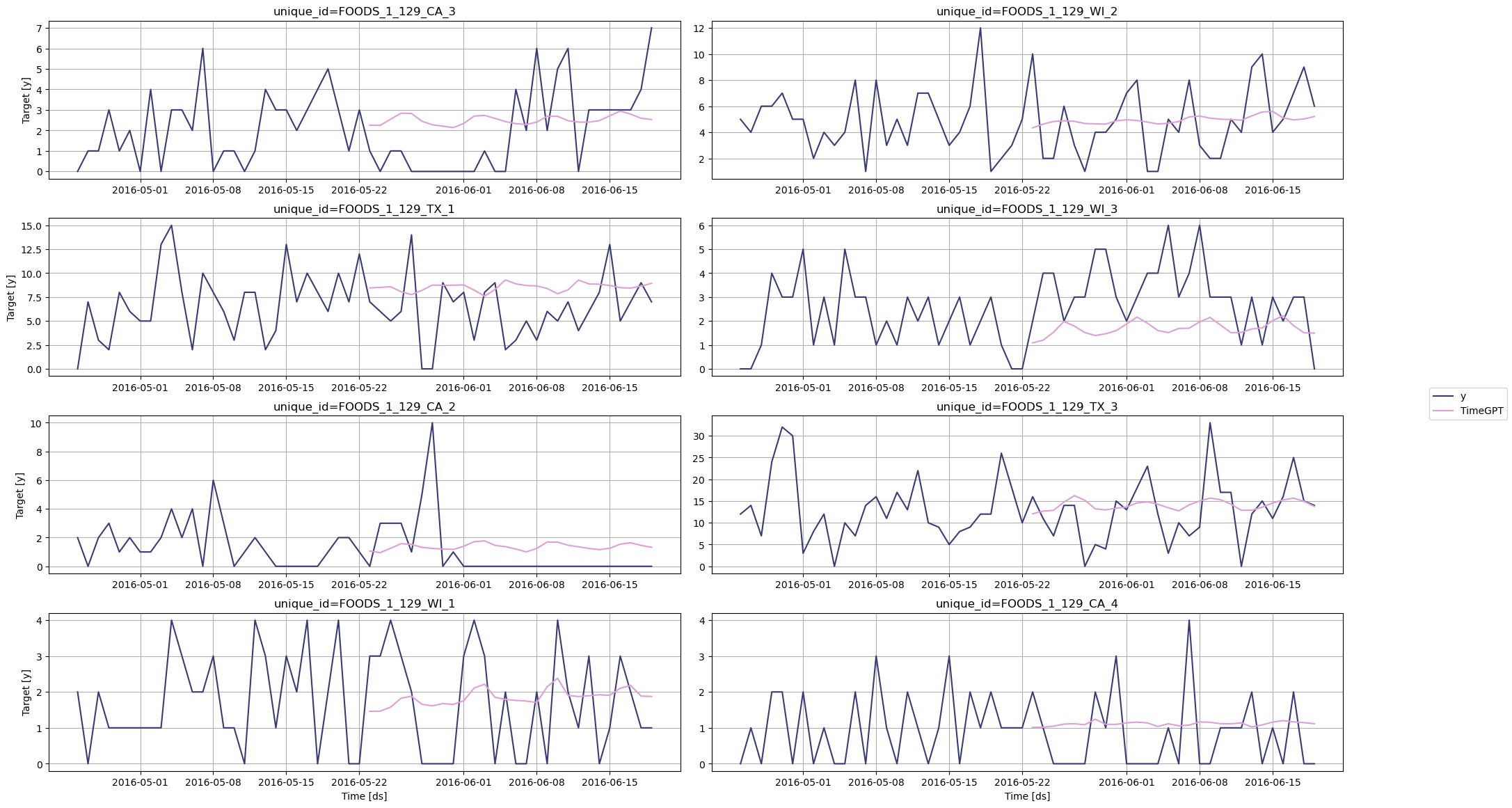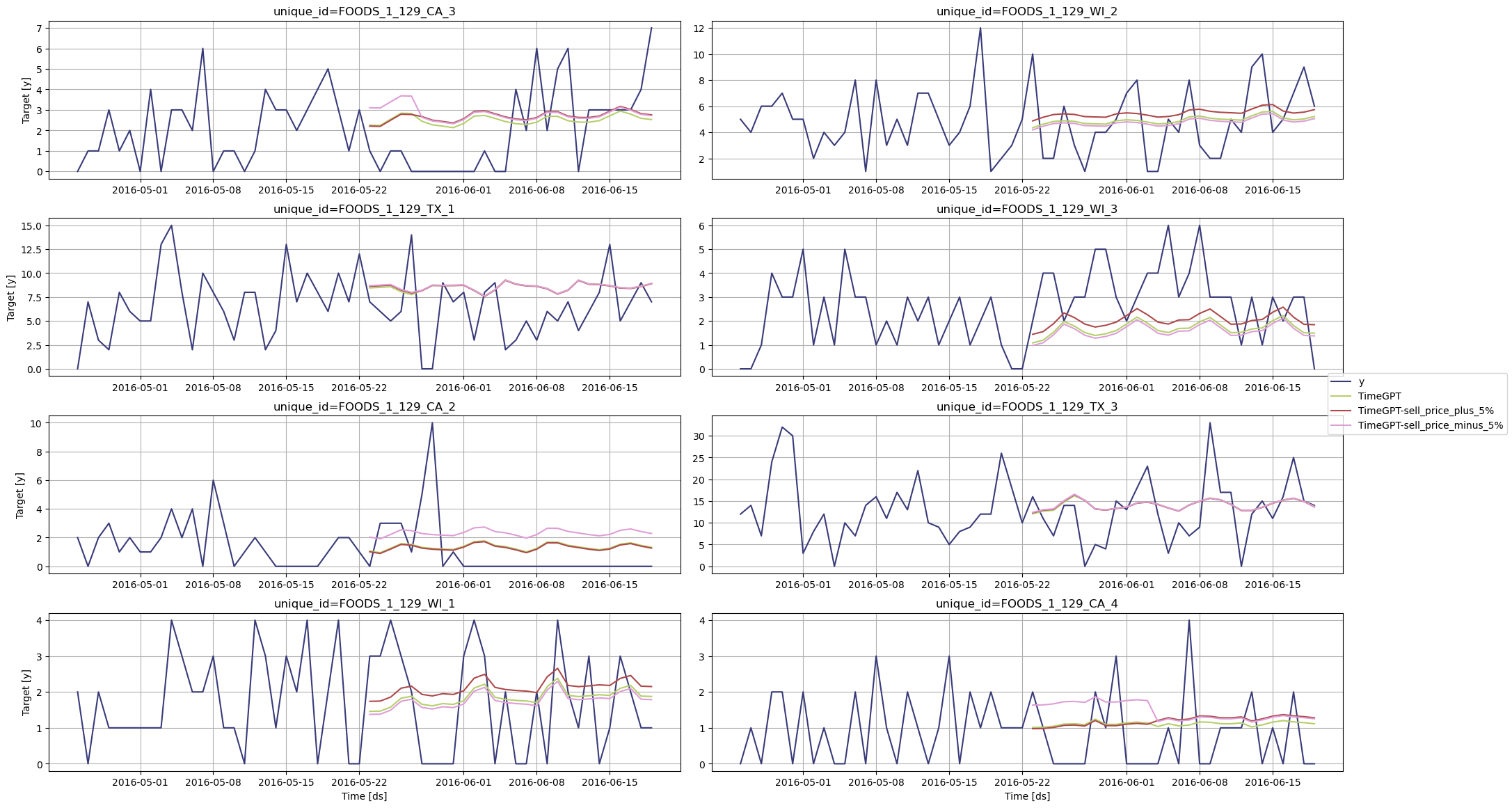1. Import packages
First, we import the required packages and initialize the Nixtla client.👍 Use an Azure AI endpoint To use an Azure AI endpoint, remember to set also thebase_urlargument:nixtla_client = NixtlaClient(base_url="you azure ai endpoint", api_key="your api_key")
2. Load M5 data
Let’s see an example on predicting sales of products of the M5 dataset. The M5 dataset contains daily product demand (sales) for 10 retail stores in the US. First, we load the data usingdatasetsforecast. This returns:
Y_df, containing the sales (ycolumn), for each unique product (unique_idcolumn) at every timestamp (dscolumn).X_df, containing additional relevant information for each unique product (unique_idcolumn) at every timestamp (dscolumn).
Tip You can find a tutorial on including exogenous variables in your forecast with TimeGPT here.
| unique_id | ds | y | |
|---|---|---|---|
| 0 | FOODS_1_001_CA_1 | 2011-01-29 | 3.0 |
| 1 | FOODS_1_001_CA_1 | 2011-01-30 | 0.0 |
| 2 | FOODS_1_001_CA_1 | 2011-01-31 | 0.0 |
| 3 | FOODS_1_001_CA_1 | 2011-02-01 | 1.0 |
| 4 | FOODS_1_001_CA_1 | 2011-02-02 | 4.0 |
| 5 | FOODS_1_001_CA_1 | 2011-02-03 | 2.0 |
| 6 | FOODS_1_001_CA_1 | 2011-02-04 | 0.0 |
| 7 | FOODS_1_001_CA_1 | 2011-02-05 | 2.0 |
| 8 | FOODS_1_001_CA_1 | 2011-02-06 | 0.0 |
| 9 | FOODS_1_001_CA_1 | 2011-02-07 | 0.0 |
sell_price. This column shows the selling price of the
product, and we expect demand to fluctuate given a different selling
price.
| unique_id | ds | sell_price | |
|---|---|---|---|
| 0 | FOODS_1_001_CA_1 | 2011-01-29 | 2.0 |
| 1 | FOODS_1_001_CA_1 | 2011-01-30 | 2.0 |
| 2 | FOODS_1_001_CA_1 | 2011-01-31 | 2.0 |
| 3 | FOODS_1_001_CA_1 | 2011-02-01 | 2.0 |
| 4 | FOODS_1_001_CA_1 | 2011-02-02 | 2.0 |
| 5 | FOODS_1_001_CA_1 | 2011-02-03 | 2.0 |
| 6 | FOODS_1_001_CA_1 | 2011-02-04 | 2.0 |
| 7 | FOODS_1_001_CA_1 | 2011-02-05 | 2.0 |
| 8 | FOODS_1_001_CA_1 | 2011-02-06 | 2.0 |
| 9 | FOODS_1_001_CA_1 | 2011-02-07 | 2.0 |
3. Forecasting demand using price as an exogenous variable
We will forecast the demand for a single product only, for all 10 retail stores in the dataset. We choose a food product with many price changes identified byFOODS_1_129_.
| unique_id | ds | y | sell_price | |
|---|---|---|---|---|
| 0 | FOODS_1_129_CA_1 | 2011-02-01 | 1.0 | 6.22 |
| 1 | FOODS_1_129_CA_1 | 2011-02-02 | 0.0 | 6.22 |
| 2 | FOODS_1_129_CA_1 | 2011-02-03 | 0.0 | 6.22 |
| 3 | FOODS_1_129_CA_1 | 2011-02-04 | 0.0 | 6.22 |
| 4 | FOODS_1_129_CA_1 | 2011-02-05 | 1.0 | 6.22 |
| 5 | FOODS_1_129_CA_1 | 2011-02-06 | 0.0 | 6.22 |
| 6 | FOODS_1_129_CA_1 | 2011-02-07 | 0.0 | 6.22 |
| 7 | FOODS_1_129_CA_1 | 2011-02-08 | 0.0 | 6.22 |
| 8 | FOODS_1_129_CA_1 | 2011-02-09 | 0.0 | 6.22 |
| 9 | FOODS_1_129_CA_1 | 2011-02-10 | 3.0 | 6.22 |
y - of these products
has evolved in the last year of data. We see that in the California
stores (with a CA_ suffix), the product has sold intermittently,
whereas in the other regions (TX and WY) sales where less
intermittent. Note that the plot only shows 8 (out of 10) stores.

sell_price of these products across the entire
data available. We find that there have been relatively few price
changes - about 20 in total - over the period 2011 - 2016. Note that the
plot only shows 8 (out of 10) stores.

sell_price exogenous variable in TimeGPT, we have to add it
as future values. Therefore, we create a future values dataframe, that
contains the unique_id, the timestamp ds, and sell_price.
| unique_id | ds | sell_price | |
|---|---|---|---|
| 1938 | FOODS_1_129_CA_1 | 2016-05-23 | 5.74 |
| 1939 | FOODS_1_129_CA_1 | 2016-05-24 | 5.74 |
| 1940 | FOODS_1_129_CA_1 | 2016-05-25 | 5.74 |
| 1941 | FOODS_1_129_CA_1 | 2016-05-26 | 5.74 |
| 1942 | FOODS_1_129_CA_1 | 2016-05-27 | 5.74 |
| 1943 | FOODS_1_129_CA_1 | 2016-05-28 | 5.74 |
| 1944 | FOODS_1_129_CA_1 | 2016-05-29 | 5.74 |
| 1945 | FOODS_1_129_CA_1 | 2016-05-30 | 5.74 |
| 1946 | FOODS_1_129_CA_1 | 2016-05-31 | 5.74 |
| 1947 | FOODS_1_129_CA_1 | 2016-06-01 | 5.74 |
| unique_id | ds | y | sell_price | |
|---|---|---|---|---|
| 19640 | FOODS_1_129_WI_3 | 2016-05-13 | 3.0 | 7.23 |
| 19641 | FOODS_1_129_WI_3 | 2016-05-14 | 1.0 | 7.23 |
| 19642 | FOODS_1_129_WI_3 | 2016-05-15 | 2.0 | 7.23 |
| 19643 | FOODS_1_129_WI_3 | 2016-05-16 | 3.0 | 7.23 |
| 19644 | FOODS_1_129_WI_3 | 2016-05-17 | 1.0 | 7.23 |
| 19645 | FOODS_1_129_WI_3 | 2016-05-18 | 2.0 | 7.23 |
| 19646 | FOODS_1_129_WI_3 | 2016-05-19 | 3.0 | 7.23 |
| 19647 | FOODS_1_129_WI_3 | 2016-05-20 | 1.0 | 7.23 |
| 19648 | FOODS_1_129_WI_3 | 2016-05-21 | 0.0 | 7.23 |
| 19649 | FOODS_1_129_WI_3 | 2016-05-22 | 0.0 | 7.23 |
forecast method of TimeGPT:
| unique_id | ds | TimeGPT | |
|---|---|---|---|
| 0 | FOODS_1_129_CA_1 | 2016-05-23 | 0.875594 |
| 1 | FOODS_1_129_CA_1 | 2016-05-24 | 0.777731 |
| 2 | FOODS_1_129_CA_1 | 2016-05-25 | 0.786871 |
| 3 | FOODS_1_129_CA_1 | 2016-05-26 | 0.828223 |
| 4 | FOODS_1_129_CA_1 | 2016-05-27 | 0.791228 |
📘 Available models in Azure AI If you are using an Azure AI endpoint, please be sure to setWe plot the forecast, the actuals and the last 28 days before the forecast period:model="azureai":nixtla_client.forecast(..., model="azureai")For the public API, we support two models:timegpt-1andtimegpt-1-long-horizon. By default,timegpt-1is used. Please see this tutorial on how and when to usetimegpt-1-long-horizon.

4. What if? Varying price when forecasting demand
What happens when we change the price of the products in our forecast period? Let’s see how our forecast changes when we increase and decrease thesell_price by 5%.
📘 Available models in Azure AI If you are using an Azure AI endpoint, please be sure to setLet’s combine our three forecasts. We see that - as we expect - demand is expected to slightly increase (decrease) if we reduce (increase) the price. In other words, a cheaper product leads to higher sales and vice versa.model="azureai":nixtla_client.forecast(..., model="azureai")For the public API, we support two models:timegpt-1andtimegpt-1-long-horizon. By default,timegpt-1is used. Please see this tutorial on how and when to usetimegpt-1-long-horizon.
Note Price elasticity is a measure of how sensitive the (product) demand is to a change in price. Read more about it here.
| unique_id | ds | TimeGPT | TimeGPT-sell_price_plus_5% | TimeGPT-sell_price_minus_5% | |
|---|---|---|---|---|---|
| 0 | FOODS_1_129_CA_1 | 2016-05-23 | 0.875594 | 0.847006 | 1.370029 |
| 1 | FOODS_1_129_CA_1 | 2016-05-24 | 0.777731 | 0.749142 | 1.272166 |
| 2 | FOODS_1_129_CA_1 | 2016-05-25 | 0.786871 | 0.758283 | 1.281306 |
| 3 | FOODS_1_129_CA_1 | 2016-05-26 | 0.828223 | 0.799635 | 1.322658 |
| 4 | FOODS_1_129_CA_1 | 2016-05-27 | 0.791228 | 0.762640 | 1.285663 |
| 5 | FOODS_1_129_CA_1 | 2016-05-28 | 0.819133 | 0.790545 | 1.313568 |
| 6 | FOODS_1_129_CA_1 | 2016-05-29 | 0.839992 | 0.811404 | 1.334427 |
| 7 | FOODS_1_129_CA_1 | 2016-05-30 | 0.843070 | 0.814481 | 1.337505 |
| 8 | FOODS_1_129_CA_1 | 2016-05-31 | 0.833089 | 0.804500 | 1.327524 |
| 9 | FOODS_1_129_CA_1 | 2016-06-01 | 0.855032 | 0.826443 | 1.349467 |

Important
- This method assumes that historical demand and price behaviour is predictive of future demand, and omits other factors affecting demand. To include these other factors, use additional exogenous variables that provide the model with more context about the factors influencing demand.
- This method is sensitive to unmodelled events that affect the demand, such as sudden market shifts. To include those, use additional exogenous variables indicating such sudden shifts if they have been observed in the past too.

